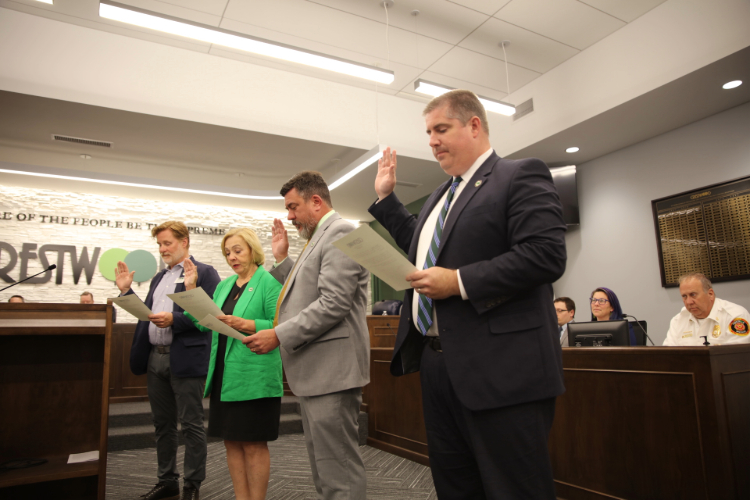Lindbergh School District officials saved district taxpayers more than $2.1 million by seeking bids for the sale of roughly $13.8 million in bonds to fund Proposition R 2008 projects.
Board members recently voted unanimously to approve the sale of a total of $13,833,953.55 in tax-exempt general obligation capital appreciation bonds and taxable general obligation Build America bonds. This was the third and final sale of bonds for Proposition R 2008, a $31 million bond issue approved by voters in November 2008.
Prop R 2008 did not increase Lindbergh’s debt-service tax rate, but extended the existing rate of 38 cents per $100 of assessed valuation an additional five years.
The Board of Education placed Prop R 2008 on the ballot with the goal of providing a long-term solution to space concerns at Sperreng Middle School.
More than 1,300 sixth-, seventh- and eighth-graders are jammed into the middle school that was designed to accommodate 800 pupils when it opened in 1970.
While Sperreng will remain a sixth- through eighth-grade middle school, funds from Prop R 2008 will be used to convert Truman Elementary School to a sixth- through eighth-grade middle school, add onto Crestwood and Long elementary schools, convert Concord School to an elementary school and construct a new Early Childhood Education building next to the Administration Building at 4900 S. Lindbergh Blvd.
Eight bids were submitted to purchase $4,833,953.55 of capital appreciation bonds, which were sold to Morgan Keegan & Co. of Memphis, Tenn. Morgan Keegan & Co.’s true interest cost of 4.458478 percent was the lowest of the eight bids submitted, according to Chief Financial Officer Pat Lanane and the district’s financial adviser, Joy Howard of WM Financial Strategies.
Seven bids were submitted to purchase $9 million of Build America bonds, which were sold to Robert W. Baird & Co. Inc. of Red Bank, N.J. Robert W. Baird & Co.’s true interest cost of 3.69327 percent was the lowest of the seven bids submitted.
“… We do open, competitive bid sales in this school district,” Lanane told the Board of Education March 9, noting the bonds were sold earlier that day. “And, in fact, today we conducted only the second one that’s been done in this state of a particular type of bond …
“I am very pleased with the results that we had today. It’s always a little bit scary. You don’t know what the market’s going to do on any given day or week. We seem to hit the market well today. We’re very pleased with the report tonight. I think the bidding, as you’ll see the spread in pricing, absolutely was the right thing to do …,” he said.
The chief financial officer noted revenue from the Prop R 2008 bonds cannot be spent on operating expenses, including salaries.
“… These bonds we sold today are for construction and construction only. We cannot use them — as much as we’d like — for operational items and none of the items on the list that you’ll see later can be covered by the cost of these bonds,” Lanane said, referring to a list of more than $4.7 million in reductions the board later approved for the coming school year. “They are voted on by the public for the express purpose they be used for certain projects … So we can only use it for those purposes. We have a severe overcrowding problem at our middle school and some of our elementaries are beginning to fill up as well.
“So it was a problem that had to be addressed. The only way to address it is more space and so this solves that problem. On the facility side of things, we’re OK, and this will really kind of solve some deep-seated problems for the foreseeable future …”
Board Vice President Vic Lenz said, “When you say that we can only spend it for the buildings, that is not our choice. That’s the law.”
Lanane said, “That is state law.”
Lenz said, “That’s state law. I just wanted to make that clear to everybody that it’s not our choice that we only spend it for buildings. That’s the law.”
Lanane said, “And I actually agree with it because when voters go, that’s a sacred trust. When they say: OK, you can use my taxes for that purpose, that’s probably exactly what they mean. So even if it were possible, it would be a hard thing to ever recommend. It breaks a trust. So it not only would break a trust, it would also break the law if we were to try to do that …”
Regarding the capital appreciation bonds, Howard said, “… They accrue interest and don’t pay interest until the maturity. And the reason why we’re using this, it’s a tool that schools sometime use where you have bonds overlapping bond issues and you’re trying to keep your tax levy down. So it’s not the most efficient kind of bond, so we try and limit the amount. So this was based on careful modeling to keep the amount of capital appreciation bonds down as much as possible and simultaneously keep your tax levy down as much as possible.”
As Lanane noted earlier, the competitive sale of the capital appreciation bonds was only the second in the state.
“It’s only the second issue of capital appreciation bonds sold competitively in the state and I’ll take credit for the first one, too,” Howard said. “It’s been a while since I did the first one, but it went so well that I felt like there was no reason that this issue shouldn’t be done competitively just like any other type.
“And you can see with eight bids, there was a strong appetite for the issue,” she said, noting the difference between the high bid and low bid is almost 1 percent in interest and results in a savings of $1.63 million to Lindbergh taxpayers.
Regarding the Build America Bonds, Howard said, “… Instead of the issue being a traditional tax-exempt issue, the interest rates are taxable in the hands of the investor and so if you look at the rates, there were only two maturities. But the winning bidder was a 5.5 in 2029 and a 5.6 (in 2030), a much higher rate than any of the issues we’ve done in any history that I can remember for the district.
“And that’s because they’re taxable. But in exchange, the government gives you back 35 percent of the interest for each interest payment date … You’ll get back as a subsidy from the federal government approximately $3.5 million …”
She noted that while the investor will receive interest rates of 5.5 percent and 5.6 percent, the true interest cost to the district will be 3.69327 percent.
Furthermore, the difference between the low bid and the high bid equals a savings of nearly $480,000 to Lindbergh taxpayers.


















